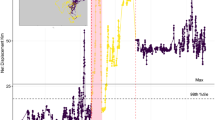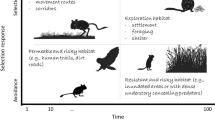Abstract
Context
Corridors are usually delineated as areas of minimum cumulative resistance to movement through a resistance surface and characterized by their effective distance (accumulated resistance along the least-cost path). The results of these assessments depend on resistance values, which are typically derived from the inverse of habitat suitability models or from presence data of individuals within their home ranges, rather than from data on dispersal or exploratory movements.
Objective
Evaluate the extent to which corridor delineation and effective distance estimates may vary depending on whether home range locations or dispersal data are used to characterize species habitat selection and landscape resistance to movement.
Methods
We analyzed a large telemetry dataset (GPS collars) for the endangered Iberian lynx. We modeled corridors and effective distances three ways: (1) considering only GPS locations within home ranges, (2) considering only locations in dispersal or exploratory movements outside home ranges, and (3) considering all locations together.
Results
Delineated least-cost corridors followed similar trajectories and sometimes overlapped in the three models. The estimated effective distances were 42 % lower in the dispersal-based model than in the model based solely on home range use.
Conclusions
Models derived exclusively from locations within home ranges may provide lower connectivity estimates than models derived from dispersal locations, affecting estimates of resistance to move between habitat areas, even when the most likely movement routes are similar. Although dispersal data are costly to gather, they potentially provide more realistic assessments of the actual isolation of populations in heterogeneous landscapes.




Similar content being viewed by others
References
Adriaensen F, Chardon JP, De Blust G, Swinnen E, Villalba S, Gulinck H, Matthysen E (2003) The application of ‘least-cost’ modelling as a functional landscape model. Landscape Urban Plan 64:233–247
Allen ML, Wittmer HU, Wilmers CC (2014) Puma communication behaviours: understanding functional use and variation among sex and age classes. Behaviour 151:819–840
Baguette M, Blanchet S, Legrand D, Stevens VM, Turlure C (2013) Individual dispersal, landscape connectivity and ecological networks. Biol Rev 88:310–326
Baguette M, Van Dyck H (2007) Landscape connectivity and animal behavior: functional grain as a key determinant for dispersal. Landscape Ecol 22:1117–1129
Beier P, Majka DR, Spencer WD (2008) Forks in the road: choices in procedures for designing wildland linkages. Conserv Biol 22:836–851
Bélisle M (2005) Measuring landscape connectivity: the challenge of behavioral landscape ecology. Ecology 86:1988–1995
Beyer HL, Haydon DT, Morales JM, Frair JL, Hebblewhite M, Mitchell M, Matthiopoulos J (2010) The interpretation of habitat preference metrics under use-availability designs. Philos Trans R Soc B 365:2245–2254
Cagnacci F, Boitani L, Powell RA, Boyce MS (2010) Animal ecology meets GPS-based radiotelemetry: a perfect storm of opportunities and challenges. Philos Trans R Soc B 365:2157–2162
Chetkiewicz CLB, St. Clair CC, Boyle MS (2006) Corridors for conservation: integrating pattern and process. Annu Rev Ecol Evol S 37:843–856
Crooks KR, Sanjayan M (2006) Connectivity conservation. Cambridge University Press, Cambridge
D’Eon RG, Glenn SM, Parfitt I, Fortin MJ (2002) Landscape connectivity as a function of scale and organism vagility in a real forested landscape. Conserv Ecol 6:10
Drielsma M, Manion G, Ferrier S (2007) The spatial links tool: automated mapping of habitat linkages in variegated landscapes. Ecol Model 200:403–411
Elliot NB, Cushman SA, Loveridge AJ, Mtare G, Macdonald DW (2014a) Movements vary according to the dispersal stage, group size, and rainfall: the case of the African lion. Ecology 95:2860–2869
Elliot NB, Cushman SA, Macdonald DW, Loveridge AJ (2014b) The devil is in the dispersers: predictions of landscape connectivity change with demography. J Appl Ecol 51:1169–1178
Ferreras P, Aldama JJ, Beltrán JF, Delibes M (1992) Rates and causes of mortality in a fragmented population of Iberian lynx Felis pardina Temminck 1824. Biol Conserv 61:197–202
Fritz H, Said H, Weimerskirch H (2003) Scale-dependent hierarchical adjustments of movement patterns in a long-range foraging seabird. Proc R Soc Lond 270:1143–1148
Gastón A, Blazquez-Cabrera S, Garrote G, Mateo-Sánchez MC, Beier P, Simón MA, Saura S (2016) Response to agriculture by a woodland species depends on cover type and behavioral state: insights from resident and dispersing Iberian lynx. J Appl Ecol. doi:10.1111/1365-2664.12629
Getz WM, Fortmann-Roe S, Cross PC, Lyons AJ, Ryan SJ, Wilmers CC (2007) LoCoH: nonparameteric kernel methods for constructing home ranges and utilization distributions. PLoS One 2:e207
Gil-Sánchez JM, Arenas-Rojas R, García-Tardío M, Rodríguez-Siles J, Simón-Mata MA (2011) Habitat assessment to select areas for reintroduction of the endangered Iberian lynx. Wildl Biol Pract 7:1–19
Graham CH (2001) Factors influencing movement pattern of keel-billed toucans in a fragmented tropical landscape in southern Mexico. Conserv Biol 15:1789–1798
Gurarie E, Andrews RD, Laidre KL (2009) A novel method for identifying behavioral changes in animal movement data. Ecol Lett 12:395–408
Guzmán JN, García FJ, Garrote G, Pérez de Ayala R, Iglesias C (2004) El lince ibérico (Lynx pardinus) en España y Portugal. Censo-diagnóstico de sus poblaciones. Dirección General para la Biodiversidad, Madrid
Keeley ATH, Beier P, Gagnon JW (2016) Estimating landscape resistance from habitat suitability: effects of data source and nonlinearities. Landscape Ecol. doi:10.1007/s10980-016-0387-5
Killeen J, Thurfjell H, Ciuti S, Paton D, Musiani M, Boyce MS (2014) Habitat selection during ungulate dispersal and exploratory movement at broad and fine scale with implications for conservation management. Mov Ecol 2:15
Kool JT, Moilanen A, Treml EA (2012) Population connectivity: recent advances and new perspectives. Landscape Ecol 28:165–185
LaRue MA, Nielsen CK (2008) Modelling potential dispersal corridors for cougars in midwestern North America using least-cost path methods. Ecol Model 212:372–381
Luque S, Saura S, Fortin MJ (2012) Landscape connectivity analysis for conservation: insights from combining new methods with ecological and genetic data. Landscape Ecol 27:153–157
Mateo-Sánchez MC, Balkenhol N, Cushman S, Pérez T, Domínguez A, Saura S (2015) Estimating effective landscape distances and movement corridors: comparison of habitat and genetic data. Ecosphere 6:59
McRae BH, Kavanagh DM (2011) Linkage mapper connectivity analysis software, the nature conservancy. Seattle. http://www.circuitscape.org/linkagemapper
Morales JM, Ellner SP (2002) Scaling up animal movements in heterogeneous landscapes: the importance of behavior. Ecology 83:2240–2247
Morales JM, Haydon DT, Frair J, Holsinger KE, Fryxell JM (2004) Extracting more out of relocation data: building movement models as mixtures of random walks. Ecology 85:2436–2445
O’Brien D, Manseau M, Fall A, Fortin MJ (2006) Testing the importance of spatial configuration of winter habitat for woodland caribou: an application of graph theory. Biol Conserv 130:70–83
Palomares F (2001) Vegetation structure and prey abundance requirements of the Iberian lynx: implications for the design of reserves and corridors. J Appl Ecol 38:9–18
R Development Core Team (2014) R: a language and environment for statistical computing. R Foundation for Statistical Computing, Vienna. http://www.R-project.org. Accessed Mar 2014
Rayfield B, Fortin MJ, Fall A (2011) Connectivity for conservation: a framework to classify network measures. Ecology 92:847–858
Rodríguez A, Delibes M (2002) Internal structure and patterns of contraction in the geographic range of the Iberian lynx. Ecography 3:314–328
Ruth TK, Buotte PC, Howard BQ (2010) Comparing ground telemetry and global positioning system methods to determine cougar kill rates. J Wildl Manag 74:1122–1133
Sawyer H, Nielson RM, Lindzey FG, Keith L, Powell JH, Abraham AA (2011) Habitat selection of rocky mountain elk in a nonforested environment. J Wildl Manag 71:868–874
Schadt S, Knauer F, Kaczensky P, Revilla E, Wiegand T, Trepl L (2002a) Rule-based assessment of suitable habitat and patch connectivity for the Eurasian lynx. Ecol Appl 12:1469–1483
Schadt S, Revilla E, Wiegand T, Knauer F, Kaczensky P, Breitenmoser U, Bufka L, Cervený J, Koubek P, Huber T, Staniša C, Trepl L (2002b) Assessing the suitability of central European landscapes for the reintroduction of Eurasian lynx. J Appl Ecol 39:189–203
Shirk AJ, Wallin DO, Cushman SA, Rice CG, Warheit KI (2010) Inferring landscape effects on gene flow: a new model selection framework. Mol Ecol 19:3603–3619
Simón MA (2015) Censo de las poblaciones ibéricas de lince ibérico: año 2015. LIFE+ Iberlince project. http://www.iberlince.eu/images/docs/3_InformesLIFE/Informe_Censo_2015.pdf. Accessed Apr 2016
Simón MA, Gil-Sánchez JM, Ruiz G, Garrote G, Mccain EB, Fernandez L, Lopez-Parra M, Rojas E, Arenas-Rojas R, Del Rey T, García-Tardío M, Lopez G (2012) Reverse of the decline of the endangered Iberian lynx. Conserv Biol 26:731–736
Squires JR, DeCesare NJ, Olson LE, Kolbe JA, Hebblewhite M, Parks SA (2013) Combining resource selection and movement behavior to predict corridors for Canada lynx at their southern range periphery. Biol Conserv 157:187–195
Stevens VM, Polus E, Wesselingh RA, Schtickzelle N, Baguette M (2004) Quantifying functional connectivity: experimental evidence for patch-specific resistance in the Natterjack toad (Bufo calamita). Landscape Ecol 19:829–842
Trainor AM, Walters JR, Morris WF, Sexton J, Moody A (2013) Empirical estimation of dispersal resistance surface: a case study with red-cockaded woodpeckers. Landscape Ecol 28:755–767
Van Dyck H, Baguette M (2005) Dispersal behavior in fragmented landscapes: routine or special movements? Basic Appl Ecol 6:535–545
Vasudev D, Fletcher RJ Jr, Goswami VR, Krishnadas M (2015) From dispersal constraints to landscape connectivity: lessons from species distribution modeling. Ecography 38:1–12
Whitmee S, Orme DL (2013) Predicting dispersal distance in mammals: a trait-based approach. J Anim Ecol 82:211–221
Wilmers CC, Wang YW, Nickel B, Houghtaling P, Shakeri Y, Allen ML, Kermish-Wells J, Yovovich V, Williams T (2013) Scale dependent behavioral responses to human development by a large predator, the puma. PLoS One 8:e60590
With KA, Gardner RH, Turner MG (1997) Landscape connectivity and population distributions in heterogeneous environments. Oikos 78:151–169
Zeller KA, McGarigal K, Beier P, Cushman SA, Vickers TW, Boyce WM (2014) Sensitivity of landscape resistance estimates based on point selection functions to scale and behavioral state: pumas as a case study. Landscape Ecol 29:541–555
Zeller KA, McGarigal K, Whiteley AR (2012) Estimating landscape resistance to movement: a review. Landscape Ecol 27:777–797
Acknowledgments
We thank Carlos Ciudad Trilla, Lorena Herrera, and two anonymous reviewers for comments that improved the paper. Funding was provided by Grants BES-2010-032250 (FPI) and AGL-2012-31099 (GEFOUR) from the Spanish Ministry of Economy and Competitiveness, by LIFE Projects LIFE10NAT/ES/000570 and LIFE06NAT/E/000209, and by Junta de Andalucía (Grant NET549314). We thank all the staff of the LIFE projects involved in Iberian lynx collaring and tracking from 2009 to 2013.
Author information
Authors and Affiliations
Corresponding author
Rights and permissions
About this article
Cite this article
Blazquez-Cabrera, S., Gastón, A., Beier, P. et al. Influence of separating home range and dispersal movements on characterizing corridors and effective distances. Landscape Ecol 31, 2355–2366 (2016). https://doi.org/10.1007/s10980-016-0407-5
Received:
Accepted:
Published:
Issue Date:
DOI: https://doi.org/10.1007/s10980-016-0407-5




